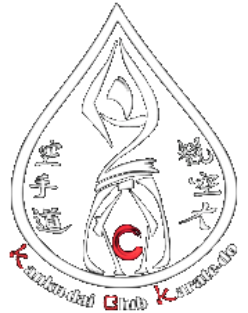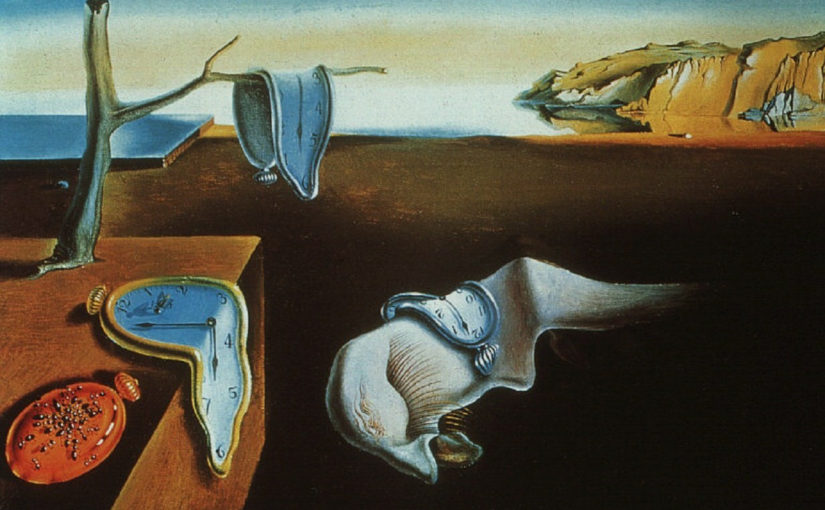In martial arts, especially in karate-do, time is fundamental. A bit like in fencing, if you think about it: touch before your opponent touches you.
(I’m afraid this post is… quite oversize! So I chose to split it in many parts. Please be patient and… enjoy!)
Well, you’d rather touch and not let anybody touch you. You see, in the past, with no antibiotics, any cutting wound could potentially be deathly. Luckily we’re living our times…
I introduced the analogy with fencing, because it’s from there that comes karate jargon. The very term 組み手 (kumi-te, that is: hands’ struggling), is simply a twisting of 組み太刀 (kumi-tachi, blades’ struggling; 手 = hand, 太刀 = long sword) used in kendo.
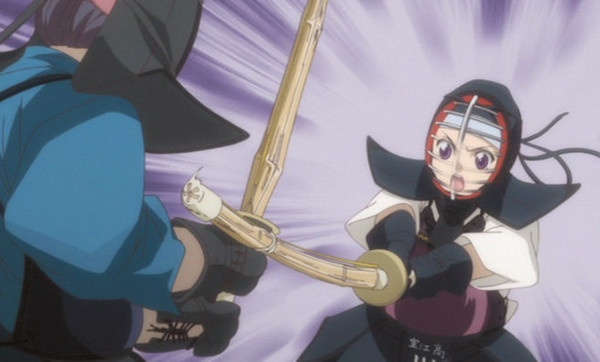
Let’s go on with fencing analogy: it is very interesting watching two children playing with swords (made of paper, wood, plastic or whatever). It’s curious that their purpose seems to be to hit the other’s sword, as if it were mandatory to clench the “blades”. Then, when they get older, something switches in their minds: now their purpose is to stab the opponent, and the swords clench only to parry.
This is the essence of fencing. And from here karate-do starts.
We are at the first stage, which is called 後の先 (go no sen).
Ok, a short break to understand the etymology (you can skip ’till next paragraph, if you fancy^_^).
The complete expression would be 後の先手 (go no sente). 先手 (sen-te) means “initiative, first move”; literally, it is “the hand coming first”. The very nice aikido sensei David Cho uses to say that sente must be used like cats use their mustaches to perceive movements. So, the complete expression 後の先手 means “[act] after (後) the first move (先手)”, as a block-counterattack action, the founding pillar of karate-do.
Do you remember the principle 空手に先手なし (karate-ni sente nashi)? There you are: a martial art like karate-do always has a defensive approach, that is a reaction after an incoming attack. What doing after, is up to you…
Master Kenji Tokitsu gives a rhythmic idea of the 後の先 (go no sen) concept, simply as “Ton-Ton-Ton”, three bell’s ringings, corresponding to the three moments of the action: «First Ton is the opponent’s attack, the second the blocking, the third the counterattack. This is the grossest pace of defense and counterattack. It is difficult to achieve victory on the opponent, because block and counterattack are in two distinct, independent phases; however, it is from here we must start to learn.» [Tok89]
That’s the reason why in our practice, we bother to reach (at least) the second stage: 対の先 (tai no sen).
対の先 (tai no sen)
The first kanji, 対 (tai), gives the idea of opposite, vis-à-vis.
In fact, in karate, especially in kumite, the tai no sen behavior means to catch your opponent’s attack in the meanwhile, using your own greater speed and force (hmmm, fine, your ki, 気), to overwhelm.
In Japanese sword’s art, there is a precise moment in your opponent’s strike (for example 正面, shoumen), when you can insert your blade (even though is a wooden blade!), in order to make it miss and change the whole situation upside down. I was about to be cut, and now I’m the one who’s cutting! Karate-do is no different: fundamental is a proper choice of timing.
Often you can hear that karate-do is a “single blow art”, meaning that perfection must synthesize in one, single, definitive technique – so to say, your opponent must lay on the ground and stand up no more…
It means that blocking and counterattack technique are fused together, in a single, fluid movement.
According to sensei Tokitsu’s terminology, we are at “Ton-ToTon”, still three ringings, of which the last two are very, very, very, closest!
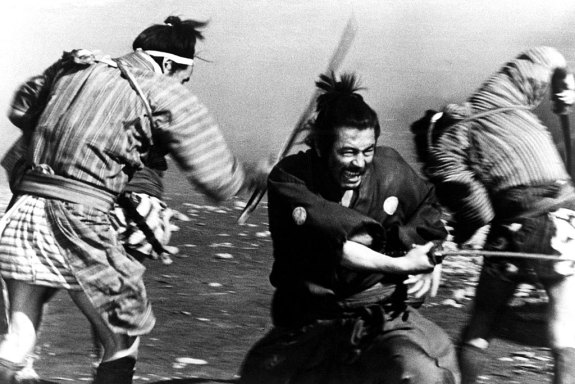
Someone else said that “kumite’s ultimate purpose is not victory, but fighting with the idea of not losing”. Effectively, I do agree, even when you put aside sport kumite – the one practiced on the dojo‘s tatami – in favor of a real fighting, when you need to defend yourself against an attacker (who’s maybe big, tall and nasty).
It is then that you must apply the concept of 対の先 (tai no sen): victory is not your opponent’s physical annihilation, as it was customary in the old days, but rather is the destruction of his/her willingness to attack.
It’s a sort of psychological and morale annihilation: “What the hell??, I was attacking and now I’m lying on the floor? What happened!?”
Well, I believe this is tai no sen.
Can we go further? Of course! It’s only a matter of… mustaches! Even if you’re not a cat.
先の先 (sen no sen)
Please forgive me if I use once more an example taken from kenjutsu (剣術, Japanese sword’s art) world. One of the purposes of a good practitioner (so, for me, a daydream!) is to find the correct timing for (counter)attacking in the very moment when the opponent is “charging” his/her technique.
As sensei Franco Criti always tells me: «When the door opens… pum!, get inside», with the obvious metaphor that the open door is the flaw in the opponent’s guard.
In karate-do there is a moment (even though it shouldn’t exist!) where you are “charging your blow”. That very instant, although could be only in the attacker’s mind, is the moment when the door opens.
It comes before (先, sen) the initiative (先手, sente). Sometimes I heard it by the name of 前の先 (mae no sen, 前 = before, forward); it is the same.
Tokitsu-sensei calls it To-Ton, where To is the incomplete blow, choked as it’s forming. Door’s open. Thus, we enter, thudding hard. No pity, c’mon!
There is a scene, taken from the movie Kuro Obi, which synthesizes the concept of 先の先 (sen no sen) in a good fashion. There you can find a fantastic Tetsuya Naka acting as the merciless Taikan. If you’ve never watched it, it’s worth a chance. The plot isn’t fabulous, quite naive I’d say, but it’s one of the few movies where the fightings are real and formally correct. And yes, I confess: I was party with Giryu^^.
先先の先 (sen sen no sen)
There is another stage (the fourth), beyond 先の先 (sen no sen). Just put another 先 in front and it’s done. No, I’m not kidding, and it’s not a Japanese tongue-twister either. It is what comes before the before of the attack. That is, the opponent you’re facing is still thinking about his attack and you… zac!, you’ve already hit. So, he didn’t move at all and you… zac!, you knocked him out.
Sorry, are you saying? Did you perceive his willingness to hurt you as a cold, rough wind? Ehm, no. It’s not fair. 空手に先手なし (karate-ni sente nashi), do you recall? Thus, do not look for justifications: this time you attacked first.
As you see, I don’t really like the idea of 先先の先 (sensen no sen). Oh yes, it’s very martial, very… samurai’s, but I’m not a samurai (luckily).
So, I believe that, despite acknowledging its importance, we should put it away. Again, according Tokitsu-sensei, now there’s only one ringing: Ton. It is the last stage before passing to… nothing, that is not to fight. He wrote: «There is who understand the pace of “nothing” as the one which allows to foresee the fight and so to avoid it.» [Tok89]
Avoid fighting
For what concerns the last stage, avoid fighting, I’d like to tell you a story told by sensei Gichin Funakoshi in his book on karate-do.
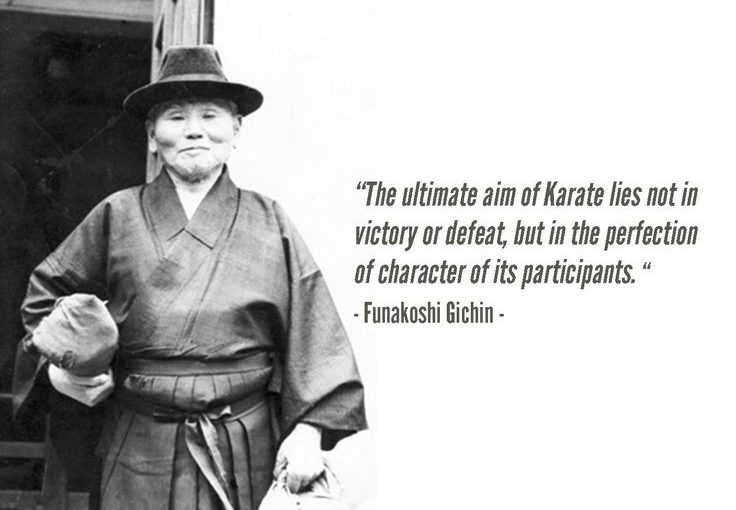
It’s a bit long, but it’s very nice story. I let him take the lead:
«Among Okinawan masters with whom I studied, there was Matsumura-sensei, about whom there was a famous tale: how he defeated another master in a duel without even fighting. That anecdote is so well-known that is almost legend, nowadays. Nonetheless, I’d like to tell it again here, because it is an utterly valuable example of the true meaning of karate-do.
It all began in the humble shop of a man in Naha, who lived on carving daily objects with drawings. Although he was already beyond his forties, he was still a vigorous man: his thick neck was like a bull’s one, under the sleeves of his kimono his muscles spread all over, his cheeks were plump and his face was tanned, the color of copper. Evidently, despite he was a modest artisan, he was also a man to esteem.
In his shop, a day, there came a man of completely different appearance, but who was also a man gifted with a great fighting spirit. He was younger than the carver, probably under thirty, most likely not beyond his thirties, and his physical structure, although less sturdy than the carver, wasn’t inferior to him. He was rather tall, about six feet, but his most impressive characteristic were his eyes: sharp and penetrating like an eagle. Nevertheless, when he strolled in the little shop, he was pale and looked quite depressed.
His voice was low while he asked for a drawing carved on his brass pipe chamber.
As he handled the long pipe, the carver asked, very politely because he was of a social class clearly inferior to his customer’s: “I beg your pardon, sir, aren’t you Mr. Matsumura, the great karate master?”
“Yes”, Matsumura replied crisply. “Why?”
“Ah, I knew I wasn’t wrong! It is a long time I’ve been hoping to study karate under you”.
But the answer of the younger man came harsh: “Sorry”, he said. “I don’t teach anymore”.
Anyway, the carver insisted. “Do you instruct the chief of the clan, don’t you?”, he asked. “Everyone says you are the best karate instructor of this place”.
“Well, I did really teach him”, replied the young visitor stiffly, “but it is not my custom to teach anyone else. And for clarity, I don’t even teach the chief of the clan anymore. To be honest”, he said, “I’m bored with karate!”
“What a curious thing to tell!” said the carver. “How can a man like you be bored with karate? Would you be so kind to explain me why?”
“I couldn’t care less”, muttered. “Teaching or not teaching to chief of the clan… It was exactly attempting to instruct him that I lost my job”.
“I can’t understand”, the carver said. “Everybody knows that you are the most renowned living master: if you quit instructing him, who’ll ever do it? For certain, no one could ever take your place”.
“In facts”, Matsumura answered, “it was exactly for my reputation that I’d been appointed with the role of instructor for the chief of the clan. But he was a poor student. He neglected his duties, did not improve his technique, that, despite all my efforts, remained very unrefined. Oh, I could have lost to him very easily, if I wanted to, but what would have been the point of it? So I highlighted his weak points and then I challenged him to attack with all his might. He immediately reacted with a double flying kick [二段蹴り, nidan-geri]. A rather good one, I must admit it, but I’ve just to tell you that only a complete beginner would use a double kick when facing an opponent who is much more experienced.
I decided to point out his mistake, to teach him an important lesson. As you know, a karate fight consists of life or death, and once you’ve made a mistake, you’re lost. It is impossible to resolve it. He knew all this by himself: but apparently he did not see it, and thus, hoping to show him the truth, I blocked his kick at once and shoved him on the floor. But before he hit the ground, he flied across the room for at least six yards”.
“Was he seriously injured?”, the carver asked.
“His shoulder, his hand, his leg where my own hand had hit him, they all got swollen”. The young man hushed for a moment. Then said again: “For a few time he couldn’t even get up from floor”.
“It is terrible!”, the carver exclaimed. “Naturally, they rebuked you”.
“Naturally. I was ordered to leave immediately and not to get back until I’d been called again”.
“I see”, said the carver, thoughtfully. “But he’ll forgive you for sure”.
“I don’t think so. Despite that accident occurred a hundred days ago, I haven’t received any more news. I was told he’s still very upset with me and says that I am too arrogant. No, I doubt he’ll grant me forgiveness. Ah”, mumbled the young master, “I’d better not even attempt to teach the chief of the clan. Rather, I shouldn’t have learnt karate in first place!”
“Rubbish!”, the carver replied. “In one man’s life there are always ups and downs. Anyway”, he added, “since you’re not teaching him anymore, why not teaching me instead?”
“No!”, Matsumura said briskly. “I left teaching. And then, why should a man like you, with your reputation as an expert, take lessons with me?” Matsumura was speaking the truth: the carver’s reputation was high both in Naha and Shuri.
“Might it not be a good reason”, the carver said, “but, honestly, I’m curious to see how you teach karate”.
Was there anything in the voice of the carver which annoyed the younger man? Was it the boldness that the chief of the clan’s teacher might become a carver’s teacher? Easy, as many young men, to get offended, Matsumura spoke contemptuously: “Such a stubborn, you are! How many times have I got to tell you: I won’t teach karate anymore!”
“Then”, the carver replied, with a far less polite tone of voice, “if you refuse to teach me, at least you won’t refuse a match, will you?”
“What’s this?” Matsumura asked, astonished. “You want a fight with me? With me?”
“Sure! Why not? In a match there are no class distinctions. Moreover, as you’re not the instructor of the chief of the clan anymore, you won’t need his authorization to fight with me. And I can make you sure I’ll pay much more attention to my legs and shoulders than he did”. Since this moment on, the carver’s words, as like as his tone, could only be heard as rude.
“They say you’re very skillful in karate”, Matsumura said. “Of course, I’ve no idea if they’re right or wrong. Anyhow, don’t you think you’ve got too far? It won’t be a matter of hurting or not: it’d be a matter of living or dying. Do you really want to die?”
“I am ready to die”, replied the man.
“Then I’ll be eager to make you this favor”, Matsumura said. “Nobody, of course, can foretell the future; but there’s an old saying: When two tigers struggle, one is destined to be wounded and the other to die. So, whether you win or lose, be certain you won’t get home unharmed. I’ll let you decide the place and the time”, truncated.
The carver suggested next morning, around five, and Matsumura agreed. The place would’ve been the graveyard of Kinbu Palace, which is behind Tama Palace.
At five o’clock the next morning, they were facing each other about twelve yards apart. The carver made the first move, covering about half the distance, forming a gedan guard with the left fist and keeping his right fist on its side. Matsumura stood up from the stone he was sitting on and faced his opponent, standing in natural stance [自然体, shizen tai], with his chin protected by his left shoulder.
Taken aback by Matsumura’s stance, the carver wondered if he’d lost his mind: Matsumura’s stance could offer no defense at all, so the carver got ready to attack.
In that very moment, Matsumura opened his eyes wide and look at the other man piercingly. The carver perceived a force like the lightening of a thunder coming from Matsumura, which kept him at bay. Matsumura hadn’t even moved a single muscle: he was standing as before, apparently unprotected.
Sweat started dripping from the carver’s forehead, and his armpits were wet; he could feel his own heart thumping unusually fast. He sat down on a close rock. Matsumura sat as well. “What happened”, muttered the carver. “Why am I sweating like this? Why is my heart beating like hell? We didn’t even come close each other!”
Then he heard Matsumura’s voice: “Hey! Come on! Sun’s risen, already. Let’s go on!”
The two men stood up again, and again Matsumura took the same guard in that natural stance. The carver, now, meant to complete his attack, so he carefully stepped towards his opponent, from twelve to ten yards, then eight… six… four. And there he froze, unable to go on, hold back by that unintelligible force spreading from Matsumura’s eyes. At he same time, he couldn’t help but looking his opponent right in the eyes; he felt as if he’d lost contact something terrible would have happened. How could he get free from that absurd situation? Suddenly he yelled a loud kiai, which sounded like a “Yach!”, thundering across the graveyard until the surrounding hills. But Matsumura stood still. Watching him, the carver felt dismay and fear.
Master Matsumura smiled. “What’s going on?” asked. “Why aren’t you attacking? You’re not supposed to fight just by shouting!”
“I can’t understand”, the carver replied. “I never lost to anyone before. And now…”. After a moment of quietness, he raised his chin and calmly told Matsumura: “Yes, let’s keep on! The outcome’s been already decided, I know, but let’s put an end to it. If we didn’t, I’ll lose face and I’d rather be dead though. I warn you, I’m about to strike in sutemi [捨て身, meaning that he decided to fight till the end]”.
“Fine!”, said Matsumura. “Come on!”
“Then forgive me, if you can!” shouted the carver, while speeding up towards Matsumura. At that very moment, the latter uttered a loud cry that sounded like a thunder. As had happened before, with the lightening in his eyes, Matsumura’s cry had frozen the carver. The man realized he couldn’t step further; he attempted one last, desperate move, before falling heavily on the ground. Few steps apart, he saw Matsumura’s head shining in the raising sun: he looked like an ancient king who was fighting demons and dragons.
“I quit!”, cried the defeated carver. “I quit!”
“What!”, Matsumura said. “This is not proper talk for an expert!”
“I was crazy to engage you!”, said the carver raising to his feet. “The result was obvious since the beginning. I’m deeply ashamed. There’s no comparison between my skills and yours”.
“Not at all”, Matsumura kindly replied. “Your fighting spirit is excellent and I believe you’re a real expert. If we’d struggled, I could have lost to you easily”.
“You are commending me”, the carver told. “Fact is I felt completely abandoned when I looked at you. I was so scared of your eyes that I mislaid any fighting spirits”.
Matsumura spoke in a hush voice: “Perhaps”, said. “But I know this: you meant to win and I did mean to die as well, if I had lost. This was the only difference between us”.
“Listen”, Matsumura went on. “When I came to your shop, yesterday, I felt very miserable for being reprimanded by the chief of the clan. When you challenged me, I was even more worried, but once we agreed on the match, all my anxieties suddenly disappeared. Then I understood that I’d been obsessed by minor business, technical improvement, ability to teach, adulation for the chief of the clan. I was only concerned to preserve my role.
Today, I’m a wiser man than I was yesterday. I am only a human being, and a human being is a vulnerable creature, who can’t possibly be perfect. After death, we return to elements, to the earth, to the water, to the fire, to the wind, to the vacuum. Matter is empty. All is emptiness. We are like grass stems, or trees in the forest, creatures of this Universe, of this Universe’s Spirit, and the Universe’s Spirit has no life nor death. Vanity is the only impediment to life”.
With this, Matsumura stopped talking. Even the carver stood still, quiet, pondering over the priceless lesson he’d been taught.
Any times, in the following years, did he tell that episode to his friends, he never failed to describe his former opponent in the best, enthusiastic way, as a man of true greatness.
About Matsumura, after a while we was called back to his job as the chief of the clan’s instructor.» [Fun87], the poor English translation (from Italian) is mine, so please refer to the English version of the book^^.
Funakoshi’s tale’s over. I always wonder: who did actually teach anything to whom?
As a matter of fact, I like to reckon that the nameless carver taught a memorable lesson to master Matsumura… Or not? Let me know in the comments!
References:
- [Fun87] Gichin Funakoshi, “Karate Do, il mio stile di vita“, 1987, Ed. Mediterranee. Original version: “Karate Do. My Way of Life”, 1975, Kodansha International-Tokyo.
- [Tok89] Kenji Tokitsu, “Lo zen e la via del karate. Per una teoria delle arti marziali“, 1989, Sugarco Edizioni. Original version: “La Voie du Karaté”, 1979, Éditions du Seuil, Paris.
- Ethan Monnot Weisgard, “Go no sen/sen no sen/sensen no sen“, in http://www.aiki-shuren-dojo.com/pdf/Go%20no%20sen.pdf
- Kuro–obi (黒帯), directed by Shunichi Nagasaki, 2007, Toei Company.
